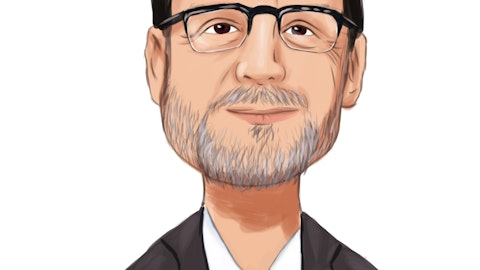Hancock Whitney Corporation (NASDAQ:HWC) Q1 2023 Earnings Call Transcript April 18, 2023
Hancock Whitney Corporation beats earnings expectations. Reported EPS is $1.45, expectations were $1.43.
Operator Good day ladies and gentlemen, and welcome to Hancock Whitney Corporation’s First Quarter 2023 Earnings Conference Call. At this time, all participants are in a listen-only mode. Later, we will conduct a question-and-answer session, and instructions will follow at that time. As a reminder, this call is being recorded.I would now like to introduce your host for today’s conference Kathryn Mistich, Investor Relations Manager. You may begin.Kathryn Mistich Thank you, and good afternoon. During today’s call, we may make forward-looking statements. We would like to remind everyone to carefully review the safe harbor language that was published with the earnings release and presentation and in the company’s most recent 10-K and 10-Q, including the risks and uncertainties identified therein.You should keep in mind that any forward-looking statements made by Hancock Whitney speak only as of the date on which they were made.
As everyone understands, the current economic environment is rapidly evolving and changing.Hancock Whitney’s ability to accurately project results or predict the effects of future plans or strategies or predict market or economic developments is inherently limited. We believe that the expectations reflected or implied by any forward-looking statements are based on reasonable assumptions, but are not guarantees of performance or results and our actual results and performance could differ materially from those set forth in our forward-looking statements.Hancock Whitney undertakes no obligation to update or revise any forward-looking statements, and you are cautioned not to place undue reliance on such forward-looking statements. Some of the remarks contain non-GAAP financial measures.
You can find reconciliations to the most comparable GAAP measures in our earnings release and financial tables. The presentation slides included in our 8-K are also posted with the conference call webcast link on the Investor Relations website. We will reference some of these slides in today’s call.Participating in today’s call are John Hairston, President and CEO; Mike Achary, CFO; and Chris Ziluca, Chief Credit Officer.I will now turn the call over to John Hairston.John Hairston Thanks Kathryn, and good afternoon everyone. Thank you for joining us today. The first quarter of 2023 was a solid start to the year, despite volatility within our industry launched by unique bank failures in early March. Despite all that noise, we’ve continued to maintain strong levels of liquidity, solid capital, and a stable season deposit base well-diversified among consumer, commercial, and wealth clients as detailed on Page 6 of the investor deck.Both linked quarter and since the bank failures the weekend of March 10, we have seen growth in total deposits, including core client segments.
In fact, the majority of our growth in core client deposits came after March 10. For the quarter, core client deposits are up 234 million of which 203 million was added post March 10.We added additional details in the deck that we believe show the strength and stability we have in our markets and among our client base. We have weathered many storms both literally and figuratively over 124 years and the name Hancock Whitney is synonymous with strength and stability in our footprint.We are pleased with deposit growth this quarter, though continued rate hikes coupled with the current banking environment and promotional CD pricing have resulted in a deposit remix to higher cost deposits. The remix has resulted in a higher than expected deposit beta for the quarter.
However, our overall deposit portfolio remains seasoned, stable, and well-diversified.Details are included on Slides 6 and 7 of our earnings deck. DDA’s as a percentage of total positives remained strong at 43% well above pre-pandemic levels. Our portfolio is diverse with 43% consumer, 36% commercial and small business, 12% public funds, 7% wealth, and only 2% brokered CDs. The brokered CDs were issued in late March as a precautionary measure only, and as of today, we don’t anticipate needing to issue anymore.Uninsured deposits were 36% at the end of March and we continue to offer varied ways for both consumers and businesses to further ensure their funds above current FDIC limits, while maintaining their primary deposit relationship with Hancock Whitney.On Slide 8, we updated our liquidity metrics, again indicating a position of strength with almost 20 billion in available sources of funds, we currently use less than 4 billion, much of which was drawn as precautionary during the height of volatility in March.
So, we sit with approximately 16 billion in net available sources of funds and the unlikely event of persistent volatility in our industry.Moving on to capital. On Slide 19, all of our capital measures have strengthened linked quarter, despite the precautionary leverage noted earlier. The 36 basis point impact of leverage added at quarter-end somewhat offset the benefit from a solid earnings result for the quarter, which should gradually reverse itself as headline volatility declines. We do note the first quarter in a while where we and many peers benefited from OCI impact to our TCE ratio.In summary, we are very mindful of the current operating environment and the macroeconomic trends, which may impact our industry. But as I just detailed, given our strong liquidity, our solid capital and stable season, diverse, and granular deposit base, we believe we are well-positioned for the environment.With that, I’ll turn the call to Mike for further comments.Mike Achary Thanks, John, and good afternoon, everyone.
The first quarter was a solid quarter with net income of 126 million and EPS of $1.45 per share. The results were down a bit from last quarter, driven primarily by a 13 basis point narrowing of our NIM, resulting from the continued remix of deposits and higher overall deposit cost. Even so, deposit growth was strong this quarter at 543 million with increases in core client deposits and brokered CDs, partly offset by typical seasonal runoff in our public fund deposit book.Going forward, we recognize that deposit growth will be a challenge for the remainder of the year, really for all banks. Clients continue to be rate sensitive, resulting in a continued shift in the mix of deposits from DDA to higher cost deposits, mostly CDs. That dynamic will likely continue for as long as rates are elevated.Given the current environment, we believe our NIM will likely compress again in the second quarter and then potentially stabilize over the second half of the year.

That’s based on an environment where the Fed raises rates again in May, then backs off from any additional rate hikes for the balance of the year.Slides 15 and 16 in the earnings deck provide additional details related to NIM in our interest rate sensitivity. Details around our securities portfolio can be found on Slide 14. The portfolio is as always conservative in composition and mostly invested in safe residential and commercial mortgage backed securities. As noted last quarter, we used the runoff in the bond portfolio of about 125 million to partially fund the quarter’s loan growth.We continue to have hedges in place to help reduce OCI volatility and provide flexibility in a changing rate environment. The details around our unrealized losses in both the AFS and HCM portfolios are noted at the bottom of the slide and have improved around 13% since last quarter.
Given questions about the impact of unrealized losses from the bond portfolio on capital, we included a set of pro forma capital ratios that look at what those ratios might be, if all unrealized losses were included in the calculations. You see that on Slide 20 in the earnings deck.The takeaway for us is that even after including all unrealized losses, we remain above well-capitalized levels with common Tier 1 capital over 9%. Taking into account the current rate environment, updated forecasts around future rate hikes and higher deposit betas, we have adjusted our annual PPNR guidance and currently expect an increase somewhere between 3% and 7% for 2023, compared to 2022.You’ll see that updated guidance on Slide 21 of the deck. Loan growth was in-line with expectations at just under 300 million or 5% linked quarter annualized.
The one-time close product in the mortgage lending portfolio was again a driver of the growth in the quarter, coupled with an increase in CRE income producing loans. This increase is mainly related to the movement of loans from the construction phase to permit financing at completion.We continue to limit our growth in CRE and have provided additional information on Slide 10. A quick comment on credit. The increase in net charge-offs was driven by a handful of smaller charge-offs and a lower level of recoveries compared to the fourth quarter. We continue to operate from low levels of commercial criticized and non-accrual loans both relatively stable this quarter and our ACL remains strong at 146 basis points.Fee income improved this quarter with wealth and specialty income, key drivers of the increase.
As a reminder, this is the first full quarter for the previously announced elimination of certain consumer NSF and OD fees and service charges. Expenses were up linked quarter, but in-line with guidance we provided last quarter.As detailed on Slide 18, other non-interest expense was the biggest category of the increase. With the higher level of expenses and compression in NIM, we ended the first quarter with an efficiency ratio of 53.8%. In today’s environment with higher deposit costs and elevated rates, we feel that the work done in prior years to produce a more efficient company continues to serve us well. We will continue to strive to deliver pure best earnings at efficiency ratio levels below 55%. I will now turn the call back to John.John Hairston Thanks Mike.
And moderator, if we could, let’s open the call for questions.
See also 15 Biggest SaaS Companies in the World and 15 Biggest Mutual Fund Companies in the World.
Question-and-Answer Session Operator [Operator Instructions]
Our first question comes from Catherine Mealor with KBW. Your line is open.Catherine Mealor Thanks. Good evening, everyone.John Hairston Hi, Catherine.Catherine Mealor I wanted to maybe start with the margin and I guess this is the million dollar question, but you’re trying to see how much deposit mix shift you’re expecting over the course of the year. We saw a big mix shift out of non-interest bearing and into CDs. As you look at your PPNR guide, how do you – how are you envisioning today where you think NIBs should bottom and then where CDs should eventually get to? Thanks.Mike Achary Yes. Hi, Catherine. Good afternoon.
It’s Mike. So, in terms of our deposit mix, again, at the end of the first quarter, we were at 43% of non-interest bearing. If we kind of think about the rate environment and where we are is, we see the Fed potentially raising rates another 25 basis points and then, kind of going flat for the balance of the year.So, under that scenario, we see that 43% probably trending toward somewhere in the 38%, 39% range by the end of this year. So, as a reminder, pre-pandemic, so call it fourth quarter of 2019, we were at 37%. So, I do think a year from now, we’ll probably be at that level or pretty close to it.Catherine Mealor Great. Okay. And I feel like as an industry, we’re generally going back to pre-pandemic levels with that mix shift. Is there any reason or what’s the case to be made that we won’t go below pre-pandemic deposit mix shift?Mike Achary Well, I think for us, we’ve done a lot of work during the pandemic years, a lot of activity around the PPP process.
And I think have brought on to our balance sheet an awful lot of good core customers. And again, a lot of those customers have operating accounts with us and that helps to make a case for, I think the non-interest bearing mix potentially going no lower than where it was when we started. But look that’s a hard thing to predict and I don’t think anybody has a crystal ball in that regard And a big assumption is what I described earlier around our view of what the Fed could possibly do.If they do something materially different than that, then obviously that could change that ultimate outcome.Catherine Mealor Yes, of course. It’s helpful to hear the way you’re thinking about that. Thank you, Mike. Go ahead, John.John Hairston Catherine, this is John.
The only thing I’ll add to it is, for several years, we focused on improving granularity in the loan portfolio and the place that we’re adding bankers the most right now, given that we’re obviously out of the liquidity deployment business and we’re in the funding core loan growth with core deposit growth.So, the types of bankers we’re adding are primarily in the smaller business purpose segments. And those segments typically fund between $1.5 and $2 of liquidity per dollar of credit. And so the more successful we are and right now that’s going very well. It’s a fastest growing segment of our deposit book. So, the faster we can grow that, the better chance we have of staying above or growing up before and certainly trying to stay no worse than at the same level we were [at pandemic] [ph].So, it’s a focus area for us and hopefully we’ll see some good results as we move through the years.
Similar to what we had happened in Q1.Catherine Mealor And then a follow-up on the margin. Is it – as we look at your PPNR guidance, is it fair to assume that we can expect the NII dollars to be down every quarter for the rest of the year. It’s hard to hear this quarter was down, but there is the day count that does impact that, but you are guiding for the margin to be lower next quarter. So, just trying to think about how you’re thinking about dollar NII in the back half of the year?Mike Achary Yes. I think the first thing is, if you look at our PPNR guidance and obviously we also give guidance, pretty explicit guidance on fees and expenses, it implies NII growth of somewhere between 6% or 7% year-over-year. So, given that we do expect some margin compression in the second quarter, We would expect NII to accordingly be down some quarter-over-quarter.





